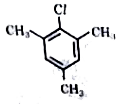Which of the following is most reactive towards nucleophilic substitution reaction ?




To determine which compound is most reactive towards nucleophilic substitution reactions, we will analyze the options provided (A, B, C, and D) based on their electrophilicity and the effects of substituents on the aromatic ring.
1. Understanding Nucleophilic Substitution:
- In a nucleophilic substitution reaction, a nucleophile attacks an electrophilic carbon atom, typically bonded to a leaving group (like a halogen). The leaving group departs, and the nucleophile takes its place.
2. Identifying Electrophilicity:
- The reactivity of the compound towards nucleophilic substitution is influenced by the electrophilicity of the carbon atom attached to the leaving group. The more positive (electrophilic) the carbon is, the more reactive it will be.
3. Analyzing Substituents:
- Substituents on the aromatic ring can either withdraw or donate electron density. Electron-withdrawing groups (EWGs) increase the electrophilicity of the carbon atom by stabilizing the positive charge that develops during the reaction. Conversely, electron-donating groups (EDGs) decrease electrophilicity by increasing electron density.
4. Evaluating Option A:
- Option A has a nitro group (−NO2) attached to the aromatic ring. The nitro group is a strong electron-withdrawing group (-M effect), which increases the electrophilicity of the carbon bonded to the leaving group (Cl). Thus, this compound is likely to be very reactive towards nucleophilic substitution.
5. Evaluating Other Options (B, C, D):
- If other options contain electron-donating groups (like alkyl groups) or weaker electron-withdrawing groups, they will decrease the electrophilicity of the carbon atom. For example, a methyl group (−CH3) would donate electron density and decrease the reactivity compared to a nitro group.
6. Conclusion:
- Based on the analysis, Option A, which contains the nitro group, will be the most reactive towards nucleophilic substitution due to its strong electron-withdrawing effect, enhancing the electrophilicity of the carbon atom.
Final Answer:
Option A is the most reactive towards nucleophilic substitution reactions.
- In a nucleophilic substitution reaction, a nucleophile attacks an electrophilic carbon atom, typically bonded to a leaving group (like a halogen). The leaving group departs, and the nucleophile takes its place.
- The reactivity of the compound towards nucleophilic substitution is influenced by the electrophilicity of the carbon atom attached to the leaving group. The more positive (electrophilic) the carbon is, the more reactive it will be.
- Substituents on the aromatic ring can either withdraw or donate electron density. Electron-withdrawing groups (EWGs) increase the electrophilicity of the carbon atom by stabilizing the positive charge that develops during the reaction. Conversely, electron-donating groups (EDGs) decrease electrophilicity by increasing electron density.
- Option A has a nitro group (−NO2) attached to the aromatic ring. The nitro group is a strong electron-withdrawing group (-M effect), which increases the electrophilicity of the carbon bonded to the leaving group (Cl). Thus, this compound is likely to be very reactive towards nucleophilic substitution.
- If other options contain electron-donating groups (like alkyl groups) or weaker electron-withdrawing groups, they will decrease the electrophilicity of the carbon atom. For example, a methyl group (−CH3) would donate electron density and decrease the reactivity compared to a nitro group.
- Based on the analysis, Option A, which contains the nitro group, will be the most reactive towards nucleophilic substitution due to its strong electron-withdrawing effect, enhancing the electrophilicity of the carbon atom.
Option A is the most reactive towards nucleophilic substitution reactions.
Topper's Solved these Questions
- QUESTION PAPER 2022 TERM 1 SET 1BOOK - XII BOARDS PREVIOUS YEARCHAPTER - QUESTION PAPER 2022 TERM 1 SET 1EXERCISE - SECTION-C
6 Videos
- QUESTION PAPER 2022 TERM 1 SET 1BOOK - XII BOARDS PREVIOUS YEARCHAPTER - QUESTION PAPER 2022 TERM 1 SET 1EXERCISE - SECTION-C
6 Videos
- POLITICAL SCIENCEBOOK - XII BOARDS PREVIOUS YEARCHAPTER - POLITICAL SCIENCEEXERCISE - SECTION-E PART-B
3 Videos
- QUESTION PAPER 2022 TERM 1 SET 2BOOK - XII BOARDS PREVIOUS YEARCHAPTER - QUESTION PAPER 2022 TERM 1 SET 2EXERCISE - SECTION -C
6 Videos
Similar Questions
Knowledge Check
Which of the following is most reactive toward nucleophilic substitution reaction ?
ACH2=CH−ClBC6H5−ClCCH3−CH=CH−ClDCl−CH2−CH=CH2Which of the following is most reactive towards nucleophilic substritution reaction?
AEthyl acetateBAcetic anhydrideCAcetamideDAcetyl chlorideWhich one of the following is most reactive towards nucleophilic substitution reaction ?
ACH2=CH−ClBC6H5ClCCH3CH=CH−ClDClCH2−CH=CH2
Which of the following is least reactive towards nucleophilic substitution?
View SolutionWhich one of the following is most reactive towards nucleophilic substitution reaction ?
View SolutionWhich of the following is most reactive towards electrophilic substituion reaction ?
View SolutionWhich of the following halide is most reactive towards Nucleophilic substitution reactions ?
View SolutionWhich of the following is the most reactive towards electrophilic substitution?
View Solution
